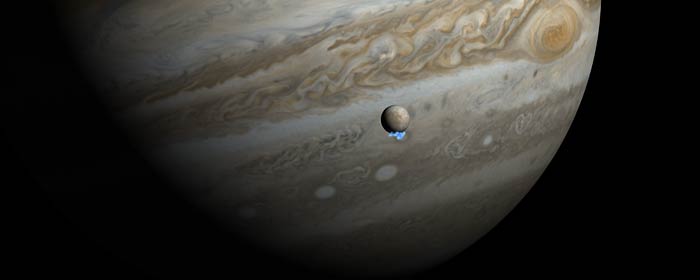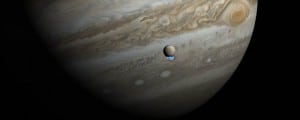
 The NASA/ESA Hubble Space Telescope has discovered water vapor erupting from the frigid surface of Jupiter’s moon Europa, in one or more localized plumes near its south pole.
The NASA/ESA Hubble Space Telescope has discovered water vapor erupting from the frigid surface of Jupiter’s moon Europa, in one or more localized plumes near its south pole.
Europa is already thought to harbor a liquid ocean beneath its icy crust, making the moon one of the main targets in the search for habitable worlds away from Earth. This new finding is the first observational evidence of water vapor being ejected off the moon’s surface.
“By far the simplest explanation for this water vapor is that it erupted from plumes on the surface of Europa,” said lead author Lorenz Roth of Southwest Research Institute in San Antonio, Texas. “If those plumes are connected with the subsurface water ocean we are confident exists under Europa’s crust, then this means that future investigations can directly investigate the chemical makeup of Europa’s potentially habitable environment without drilling through layers of ice. And that is tremendously exciting.”
“We pushed Hubble to its limits to see this very faint emission,” said co-lead author and principal investigator of the Hubble observing campaign Joachim Saur of the University of Cologne, Germany.
Hubble’s spectroscopic observations provided the evidence for Europa plumes in December 2012. Time sampling of auroral emissions measured by Hubble’s imaging spectrograph enabled the researchers to distinguish between features created by Jupiter’s magnetospheric particles and local enhancements of gas, and to also rule out more exotic explanations such as serendipitously observing a rare meteorite impact. The imaging spectrograph detected faint ultraviolet light from an aurora, powered by Jupiter’s intense magnetic field, near Europa’s south pole.
It is unknown how deep inside Europa’s crust the source of the water may be. Do the vents extend down to a subsurface ocean or are the ejecta simply from warmed ice caused by friction stresses near the surface?
*******************
THE HOLIDAYS have crept in on us, almost unnoticed (at least by this writer)—and just when we all needed a little cheering up. So let’s all “deck the halls with boughs of holly,” and not let gloom take over, even if the sky seems to be falling (it won’t).
IN A DARK TIME
All these tiny lights
Linked up in a mesh of love
Illumine our town.
STAR OF WONDER. During the holiday season, public astronomy lecturers often focus their talks on the “Christmas Star,” trying to find a logical, scientific explanation for it. Perhaps a comet, or an unusual grouping of planets, they suggest. I prefer to avoid such attempts to explain away what is, as a familiar carol says, a “star of wonder”—and let the poet in me prevail. As poet Rainer Maria Rilke put it in his book, Letters to a Young Poet, “Have patience with everything unresolved in your heart, and try to love the questions themselves.”
Isn’t it great that there is so much yet to be discovered, so many questions to be loved?
Billion-year mission:
Descrambling the wonder
Outside and inside.
Poems used in this column are copyrighted by Robert L. Eklund.


Be the first to comment